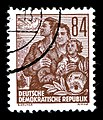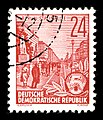Karl-Marx-Allee
You can help expand this article with text translated from the corresponding article in German. (May 2021) Click [show] for important translation instructions.
|
This article needs additional citations for verification. (May 2021) |

Karl-Marx-Allee (English: Karl Marx Avenue) is a monumental socialist boulevard built by the GDR between 1952 and 1960 in Berlin Friedrichshain and Mitte. Today the boulevard is named after Karl Marx. It should not be confused with the Karl-Marx-Straße in the Neukölln district of Berlin.
The boulevard was named Stalinallee between 1949 and 1961 (previously Große Frankfurter Straße), and was a flagship building project of East Germany's reconstruction programme after World War II. It was designed by the architects Hermann Henselmann, Hartmann, Hopp, Leucht, Paulick, and Souradny to contain spacious and luxurious apartments for workers, as well as shops, restaurants, cafés, a tourist hotel, and an enormous cinema, the Kino International.
The avenue, which is 89 metres (292 ft) wide and nearly 2 kilometres (1.2 mi) long, is lined with monumental eight-story buildings designed in the
By 1989 half the tiles on the outer facades of these buildings had fallen off,[1] necessitating sheltering structures over the sidewalks in some places to protect pedestrians.[citation needed]
A monumental
On 17 June 1953 the Stalinallee became the focus of a
Later the street was used for East Germany's annual May Day parade, featuring thousands of soldiers along with tanks and other military vehicles to showcase the power and the glory of the communist government.
De-Stalinization led to the renaming of the street, after the founder of Marxism, in late 1961. Since the collapse of Eastern European communism in 1989/1990, renaming the street back to its prewar name Große Frankfurter Straße has periodically been discussed, so far without conclusive results.
The boulevard later found favour with postmodernists, with Philip Johnson describing it as 'true city planning on the grand scale', while Aldo Rossi called it 'Europe's last great street.'[2] Since German reunification most of the buildings, including the two towers, have been restored.
Shopping
After its completion in the 1950s, the boulevard was very popular with Berliners and visitors alike. People crowded into the stores. "Taking the E line to the shops on Stalin Boulevard" was not only a catchy slogan, it was also characteristic of everyday life in the East German capital. People could find things they would not see elsewhere, and the shopping facilities set an example for the whole of the GDR. The shops offered great variety and were attractively decorated. People could relax in cafés such as Sybylle or at the Kosmos cinema, and in the evening they could take their guests to one of the representative restaurants with such sonorous names as Warschau (Warsaw), Bukarest (Bucharest) (notable for its 18% alcohol Romanian beer), or Budapest.[3]
The boulevard soon developed into a shoppers' paradise in the GDR. It also served the ideological function of introducing visitors to the culture of its "socialist sister states".
"Stalin's bathroom"
In February 2009, an anonymous author edited the article "Karl-Marx-Allee" in the German-language edition of Wikipedia, claiming that during the time of the GDR the road had acquired the nickname "Stalin's bathroom" due to the buildings' tiled façades. Subsequently, several media outlets reiterated this claim.[4][5][6] No alternative verification for the term was given, making it a self-referential claim.
After a letter written to the Berliner Zeitung questioned whether the term "Stalin's bathroom" had actually been in common use during the GDR period,[7] Andreas Kopietz, a journalist at the newspaper, published an article admitting he had invented the phrase and identifying himself as the original anonymous Wikipedia editor, allowing the record to be set straight.[8]
In popular media
The boulevard is referenced under its former name, the Stalinallee, in the
.Photographs
-
Domed Tower at Frankfurter Tor
-
Façade of a Stalinist era apartment bloc
-
Façade of a Stalinist era apartment bloc
-
Façade detail
-
Karl-Marx-Allee looking towards the Berlin TV Tower.
-
Strausberger Platz, near the western end of the boulevard
-
Karl-Marx-Allee with Frankfurter Tor and Television Tower
-
Closeup of a Stalinist era building
-
Stalinallee, 1950
-
Stalinallee, 1959
-
"5-year Plan" postage stamp series, 1953: A family standing before a high-rise near the Weberwiese subway station
-
Berlin, Stalinallee
-
Trabants on Karl-Marx-Allee
-
Aerial view over Karl-Marx-Allee, 2019
See also
- Stalinist architecture
- Seven Sisters (Moscow)
- The Straße der Pariser Kommune (street of the Paris Commune) connects with Karl-Marx-Allee
References
- ^ "Stalinallee: Palaces for the workers". Visit Berlin. Berlin Tourismus & Kongress GmbH. Retrieved 2 July 2022.
- ISBN 978-0-226-46762-7.
- ^ a b "Karl-Marx-Allee, Berlin, information board | Flickr - Photo Sharing!". Flickr. 2012-12-11. Retrieved 2014-02-04.
- ^ Das längste Baudenkmal Europas [The longest monument in Europe] in Berliner Morgenpost. 1 March 2011.
- ^ "Viel Platz, wenige Kunden". MOZ.de. Retrieved 2014-02-04.
- ^ "Nachrichten" [News] (in German). BerlinOnline.de. 2011-02-25. Retrieved 2014-02-04.
- ^ "Nachrichten" [News] (in German). BerlinOnline.de. 2011-03-01. Retrieved 2014-02-04.
- ^ "Nachrichten" [News] (in German). BerlinOnline.de. 2011-03-24. Archived from the original on 2011-09-05. Retrieved 2014-02-04.
External links
![]() Media related to Karl-Marx-Allee (Berlin) at Wikimedia Commons
Media related to Karl-Marx-Allee (Berlin) at Wikimedia Commons















